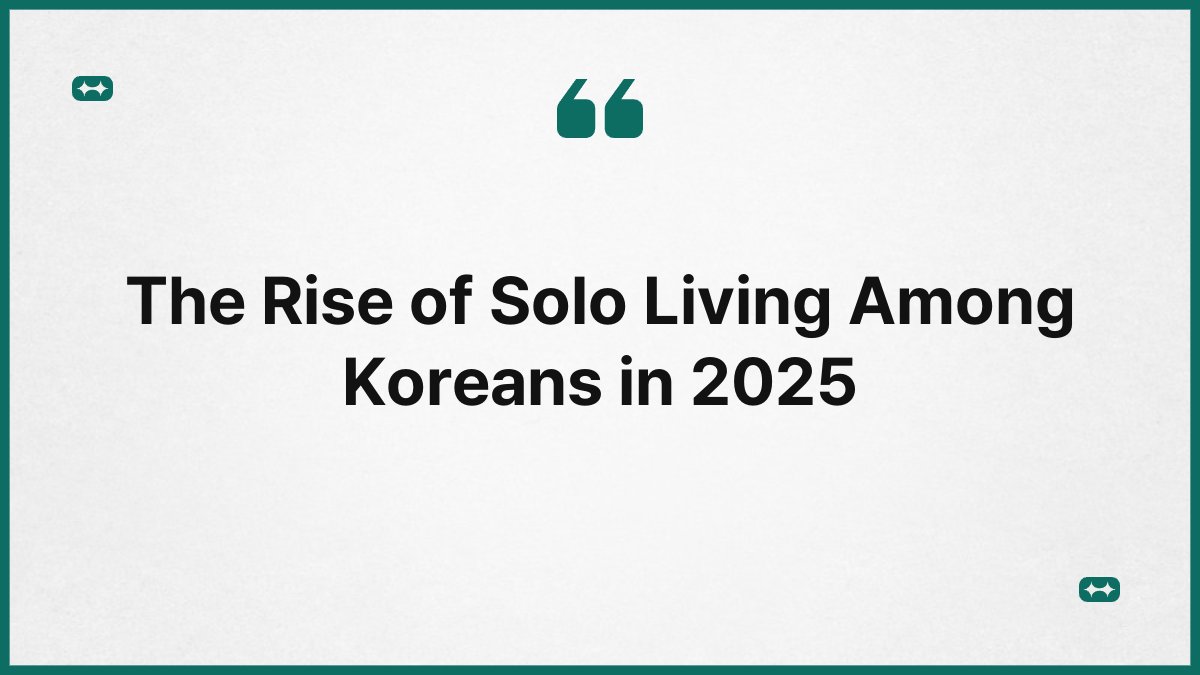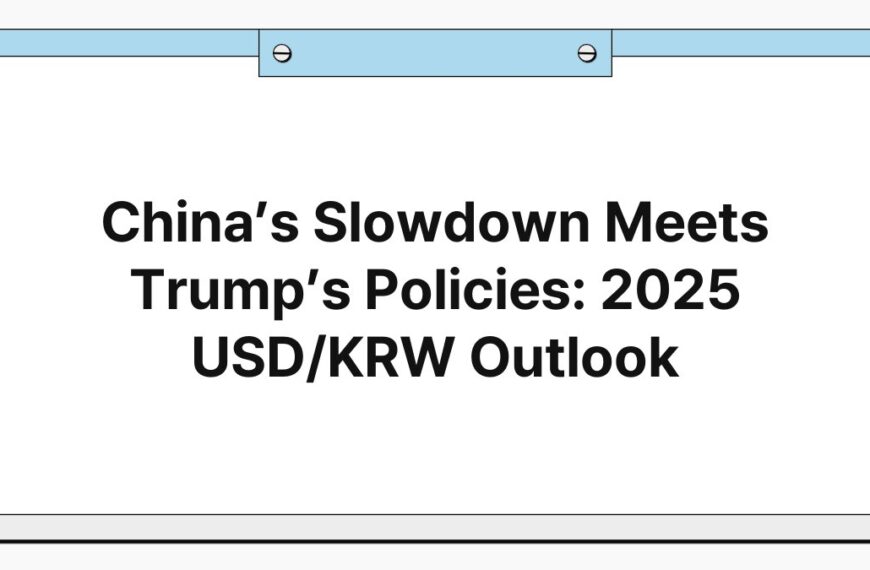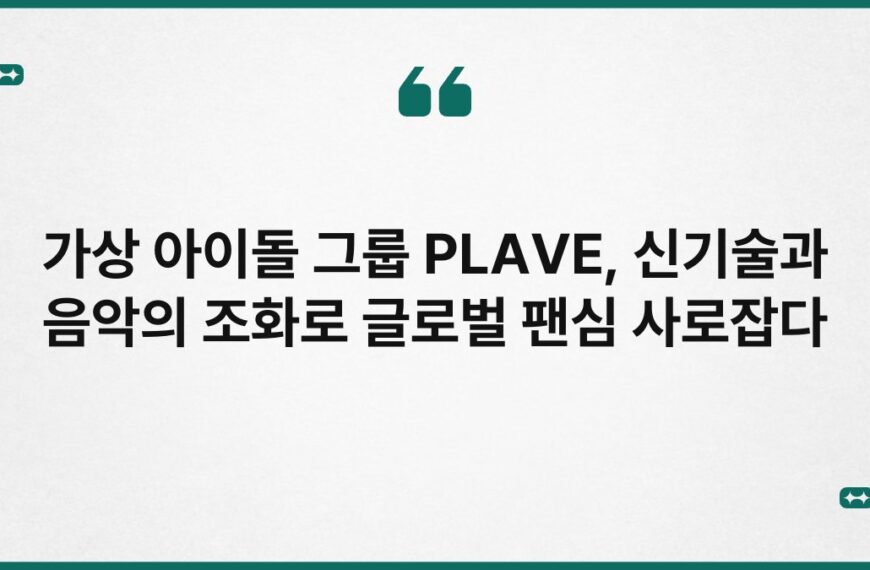[K-Bridge/Samuel] The Rise of Solo Living Among Koreans in 2025 represents a significant cultural shift in South Korea, reflecting changing societal values and lifestyles.
As more individuals opt for independence, the trend reveals a growing preference for self-sufficiency and personal freedom.
This movement is influenced by various factors, including economic pressures, changing family dynamics, and the pursuit of personal fulfillment.
By 2025, solo living is expected to become a mainstream lifestyle choice, reshaping urban landscapes and social interactions.
In this article, you will discover the motivations behind this rise, the demographic changes associated with solo living, its impact on housing and urban development, and the psychological aspects that accompany this trend.
Additionally, we will explore the social implications and future projections for solo living in South Korea.
Understanding the Motivations Behind The Rise of Solo Living Among Koreans in 2025
Economic Independence and Financial Stability
The rise of solo living among Koreans in 2025 is significantly influenced by economic independence.
Many young adults prioritize financial stability, seeking careers that allow them to support themselves without relying on family.
This shift is driven by rising living costs and the desire for a comfortable lifestyle.
Individuals are increasingly aware of their financial capabilities and are making choices that align with their economic realities.
Moreover, the gig economy has provided alternative income sources, enabling individuals to pursue freelance work or entrepreneurial ventures.
This flexibility allows them to balance work and personal life, contributing to the appeal of solo living.
As a result, many young Koreans find themselves better equipped to manage their finances independently, fostering a culture of self-reliance.
Changing Family Dynamics
The changing family dynamics in South Korea also play a pivotal role in the rise of solo living.
Traditional family structures are evolving, with an increasing number of individuals choosing to remain single or delay marriage.
The societal expectation to marry and start a family is gradually diminishing, leading to a significant shift in lifestyle preferences.
Additionally, the concept of family has expanded beyond the nuclear model.
Many young adults find fulfillment in friendships and community connections rather than traditional familial ties.
This shift allows individuals to prioritize personal growth and self-discovery, further contributing to the rise of solo living.
Personal Fulfillment and Self-Discovery
The quest for personal fulfillment is a driving force behind the rise of solo living among Koreans in 2025. Many individuals seek to explore their interests and passions, viewing solo living as an opportunity for self-discovery.
This desire for autonomy and self-actualization encourages people to embrace a lifestyle that prioritizes their personal needs and aspirations.
As individuals invest time in hobbies, travel, and self-care, they often find greater satisfaction in their lives.
The freedom to make choices without the constraints of traditional family obligations allows for a more profound exploration of identity and purpose.
This emphasis on personal fulfillment is reshaping societal norms and expectations, leading to a broader acceptance of solo living.
Demographic Changes Associated With The Rise of Solo Living Among Koreans in 2025
Age Groups Embracing Solo Living
The rise of solo living among Koreans in 2025 is particularly prominent among younger generations.
Millennials and Gen Z individuals are increasingly opting for independence, valuing experiences over material possessions.
This demographic shift indicates a significant transformation in societal values, where personal growth and exploration take precedence over traditional milestones such as marriage and home ownership.
As these age groups continue to embrace solo living, they are influencing cultural norms and expectations.
Their choices reflect a broader acceptance of diverse lifestyles, paving the way for future generations to prioritize autonomy and self-sufficiency.
Urban Migration Patterns
Urban migration patterns also play a crucial role in the rise of solo living among Koreans.
As more individuals flock to cities for educational and career opportunities, the demand for housing options that cater to solo living increases.
Urban areas are adapting to this trend by developing smaller living spaces, co-living arrangements, and shared facilities that accommodate the needs of solo dwellers.
This urbanization not only influences housing markets but also reshapes social interactions within communities.
As individuals navigate city life independently, they often seek out social networks and connections, fostering a sense of community among solo residents.
Gender Dynamics in Solo Living
Gender dynamics are also evolving in the context of solo living.
Women, in particular, are increasingly embracing independence and pursuing careers, leading to a rise in female solo dwellers.
This shift challenges traditional gender roles and expectations, promoting a more equitable society where both men and women can thrive independently.
As women continue to assert their autonomy, the narrative surrounding solo living becomes more inclusive.
This change reflects a broader societal acceptance of diverse lifestyles, encouraging individuals to pursue their passions without the constraints of traditional gender norms.
The Impact of The Rise of Solo Living Among Koreans in 2025 on Housing and Urban Development
Housing Market Adaptations
The rise of solo living among Koreans in 2025 is prompting significant adaptations in the housing market.
Developers are increasingly focusing on creating smaller, more affordable living spaces that cater to individuals rather than families.
This shift is reshaping urban landscapes, with an emphasis on efficiency and functionality in design.
Moreover, the demand for co-living spaces is on the rise, as individuals seek affordable housing options that offer community and shared amenities.
These developments reflect a growing recognition of the needs of solo dwellers, fostering a sense of belonging in urban environments.
Urban Infrastructure and Amenities
As solo living becomes more prevalent, urban infrastructure and amenities are evolving to accommodate this lifestyle.
Cities are investing in public spaces, recreational facilities, and social hubs that promote interaction among residents.
This focus on community-building enhances the quality of life for solo dwellers, providing opportunities for social engagement and connection.
Additionally, transportation systems are being adapted to support the mobility needs of individuals living alone.
As more people prioritize convenience and accessibility, cities are reimagining their transit networks to facilitate easy movement within urban areas.
Environmental Considerations
The rise of solo living among Koreans in 2025 also raises important environmental considerations.
Smaller living spaces and shared facilities often lead to reduced resource consumption, aligning with sustainable living practices.
As individuals become more conscious of their environmental impact, the trend towards solo living can contribute to more sustainable urban development.
This focus on sustainability encourages cities to prioritize eco-friendly infrastructure and green spaces, creating healthier environments for residents.
As solo living continues to rise, it presents an opportunity for urban planners to integrate sustainability into their designs, fostering a more harmonious relationship between individuals and their surroundings.
Psychological Aspects of The Rise of Solo Living Among Koreans in 2025
Mental Health and Well-Being
The psychological aspects of the rise of solo living among Koreans in 2025 are complex and multifaceted.
While many individuals find empowerment and fulfillment in their independence, there can also be challenges related to mental health and well-being.
The transition to solo living may evoke feelings of loneliness or isolation for some, necessitating a strong support network.
To mitigate these challenges, individuals are increasingly seeking out social connections and community engagement.
By fostering relationships and participating in group activities, solo dwellers can enhance their mental well-being and combat feelings of isolation.
This emphasis on social interaction underscores the importance of community in the context of solo living.
Identity and Self-Perception
The rise of solo living also influences individuals’ identity and self-perception.
As people embrace independence, they often experience a heightened sense of self-awareness and personal growth.
This journey of self-discovery allows individuals to define their values and aspirations, contributing to a more authentic sense of self.
However, this shift in identity can also lead to internal conflicts, particularly when societal expectations clash with personal desires.
Navigating these complexities requires individuals to cultivate resilience and self-acceptance, reinforcing the importance of mental health in the context of solo living.
Coping Strategies for Solo Dwellers
As solo living becomes more common, individuals are developing various coping strategies to navigate the challenges associated with this lifestyle.
Engaging in self-care practices, pursuing hobbies, and maintaining social connections are essential components of a fulfilling solo life.
These strategies empower individuals to cultivate a sense of balance and well-being.
Furthermore, many solo dwellers are turning to technology to enhance their social interactions.
Online communities and social media platforms provide opportunities for connection and support, enabling individuals to build relationships beyond their immediate surroundings.
This integration of technology into daily life reflects the evolving nature of social interactions in the context of solo living.
Social Implications of The Rise of Solo Living Among Koreans in 2025
Shifting Cultural Norms
The rise of solo living among Koreans in 2025 is indicative of shifting cultural norms and values.
As individuals prioritize personal fulfillment and independence, traditional expectations surrounding marriage and family life are being redefined.
This cultural shift encourages greater acceptance of diverse lifestyles, fostering an inclusive society that values individual choices.
Moreover, the normalization of solo living challenges the stigma often associated with being single or living alone.
As more individuals embrace this lifestyle, the narrative surrounding solo living is evolving, promoting a broader understanding of personal fulfillment beyond traditional milestones.
Community Building and Social Networks
The rise of solo living also emphasizes the importance of community building and social networks.
As individuals navigate their lives independently, they often seek out connections with like-minded individuals.
This desire for community fosters opportunities for collaboration, support, and shared experiences, enriching the lives of solo dwellers.
Community initiatives and social programs are emerging to facilitate these connections, providing spaces for individuals to interact and engage with one another.
By prioritizing community-building efforts, society can enhance the quality of life for solo residents, fostering a sense of belonging and support.
Future Projections for Social Structures
Looking ahead, the rise of solo living among Koreans in 2025 may lead to significant changes in social structures.
As more individuals embrace independence, traditional family dynamics may continue to evolve, paving the way for new forms of relationships and connections.
This shift could result in a more flexible understanding of family and community, reflecting the diverse needs and desires of individuals.
Moreover, as society adapts to these changes, there may be a greater emphasis on policies and initiatives that support solo dwellers.
This could include affordable housing options, mental health resources, and community-building programs that prioritize the well-being of individuals living independently.
Future Projections for The Rise of Solo Living Among Koreans in 2025
Continued Growth of Solo Living
The rise of solo living among Koreans is expected to continue growing in the coming years.
As societal values shift towards individuality and self-sufficiency, more individuals will likely embrace independence as a lifestyle choice.
This trend will shape urban development, housing markets, and social interactions, creating a more diverse and inclusive society.
Furthermore, as younger generations enter adulthood, their preferences for solo living will influence cultural norms and expectations.
This ongoing evolution will pave the way for future generations to prioritize autonomy and personal fulfillment, reinforcing the significance of solo living in contemporary society.
Technological Advancements and Their Impact
Technological advancements will also play a crucial role in shaping the future of solo living among Koreans.
As digital platforms continue to evolve, individuals will have greater access to resources, social connections, and opportunities for engagement.
This integration of technology into daily life will enhance the experience of solo living, providing individuals with tools to navigate their lives independently.
Moreover, advancements in smart home technology may further facilitate solo living by enhancing convenience and efficiency in daily tasks.
As individuals embrace these innovations, the landscape of solo living will continue to evolve, adapting to the changing needs and desires of residents.
Policy Implications and Support Systems
As the rise of solo living among Koreans becomes more pronounced, policymakers will need to consider the implications for social support systems.
This includes developing initiatives that address the unique needs of solo dwellers, such as affordable housing, mental health resources, and community-building programs.
By prioritizing these areas, society can foster an environment that supports individuals living independently, enhancing their overall quality of life.
In conclusion, the rise of solo living among Koreans in 2025 reflects a significant cultural shift towards independence and self-fulfillment.
As individuals navigate this evolving landscape, the implications for housing, social dynamics, and personal well-being will continue to shape the future of Korean society.
Embracing this trend presents opportunities for growth, connection, and a deeper understanding of diverse lifestyles.








